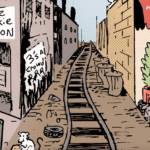 Mobile native isn’t just about look, it’s also about feel – and there’s nothing more native to the mobile experience than a tap.
Mobile native isn’t just about look, it’s also about feel – and there’s nothing more native to the mobile experience than a tap.
“Brands and users are looking for an alternative to web banners squished into mobile,” said James Cooper, head of creative at New York City-based digital ads startup Betaworks, which announced Tuesday that it would be hooking up with programmatic ad network Undertone as the exclusive distribution partner for its Tapestry ad format.
Tapestry, so named because it combines the acts of tapping and storytelling, allows brands to create mashups of their existing brand assets, including images and animated GIFs. Users progress through the full-screen content with a series of taps, almost like viewing a manual video. Although primarily developed for apps or the mobile web, Tapestry can also work in a desktop environment.
Betaworks, the company responsible for founding Chartbeat, Bitly and SocialFlow, first developed Tapestry as a consumer-facing platform for telling stories in 2012. Although adoption was all right, it wasn’t stellar, Cooper said.
“But whenever we did any work with brands, we had some really good response and engagement rates – so we started doing more of that,” he said.
Betaworks can get pretty granular in terms of analytics, including the number of taps, time spent and completion rate.
Showtime, Fox Searchlight Pictures, Dove, GE and Gucci have all experimented with the format, which according to Betaworks garners a more than 50% engagement rate regardless of the subject matter’s complexity or the number of taps it takes to complete.
For Showtime, Betaworks condensed the juiciest parts of the cable network’s trailer for “The Affair” into a series of GIFs and pics. GE blended text and animation to explain how a jet engine works in more than 30 taps, and Gucci repurposed images from a high-end photo shoot.
Click on the image below to see how it works.
“It’s a larger canvas that gives brands the chance to capture attention with interactive creative,” said Undertone co-founder Eric Franchi. “And from a user perspective, it takes advantage of the natural way people engage with their smartphones.”
The New York Times has already signed up to offer Tapestry to its advertisers, while news sharing site Digg, which Betaworks acquired in 2012, has been tapping into Tapestry for several years, seeing success with smaller advertisers, including edgy underwear retailer MeUndies.
In the case of MeUndies, users are taken directly to the brand’s ecommerce site after tapping through the unit.
It’s “actually very conversion-oriented,” said Sissi Nie, who handles business development at Digg. According to Nie, leads that engaged with a Tapestry unit were far less likely to bounce off of an advertiser’s landing page or website than users who weren’t exposed to a Tapestry unit.
“Digg has some fairly small advertisers who are very conscious of their CPA,” said Nie, who noted that Digg also uses Tapestries within its own in-house editorial content. “That’s why the native units we offer have to combine the two needs of young startups – the need for brand awareness and the need not to max out on their cost per acquisition in a DR campaign.”
Although Tapestry will only be sold on a traditional IO basis for the moment, Franchi said that Undertone has plans to make the formats programmatically available down the line.
“The vision is to give advertisers both creative and scale, but for now, this is a very different workflow than buying a standard mobile display unit,” Franchi said. “We have to get heavily involved in the design and there’s much more back and forth from a creative standpoint.”














